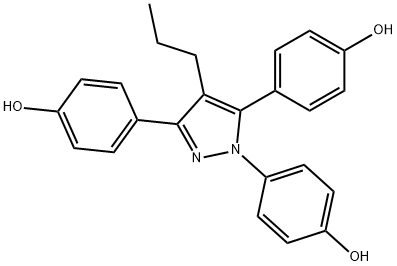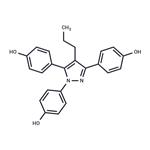Uses
PPT is a potent and specific ERα agonist.
Definition
ChEBI: 4,4',4''-(4-propylpyrazole-1,3,5-triyl)trisphenol is a pyrazole that is 1H-pyrazole bearing three 4-hydroxyphenyl substituents at positions 1, 3 and 5 as well as a propyl substituent at position 4. Potent, subtype-selective estrogen receptor agonist (EC50 ~ 200 pM); displays 410-fold selectivity for ERalpha over ERbeta. Prevents ovariectomy-induced weight gain and loss of bone mineral density, and induces gene expression in the hypothalamus following systemic administration in vivo. It has a role as an estrogen receptor agonist. It is a member of pyrazoles and a member of phenols.
General Description
Estrogen receptor α (ERα) is a member of the nuclear receptor superfamily. It is also known as ESR1 (estrogen receptor). It is located on human chromosome 6q25.1.
1,3,5-tris(4-hydroxyphenyl)-4-propyl-1H-pyrazole is also termed as PPT. ERα is found in the nuclear and extranuclear sites in principal and inhibitory neurons.
Biological Activity
Potent, subtype-selective estrogen receptor agonist (EC 50 ~ 200 pM); displays 410-fold selectivity for ER α over ER β . Prevents ovariectomy-induced weight gain and loss of bone mineral density, and induces gene expression in the hypothalamus following systemic administration in vivo .
Biochem/physiol Actions
Estrogen receptor α (ERα) is involved in immune and inflammatory responses. Aberrations in ESR1 results in Mayer-Rokitansky-Kuster-Hauser syndrome that is associated with the congenital absence of the uterus and the upper two-thirds of the vagina.


